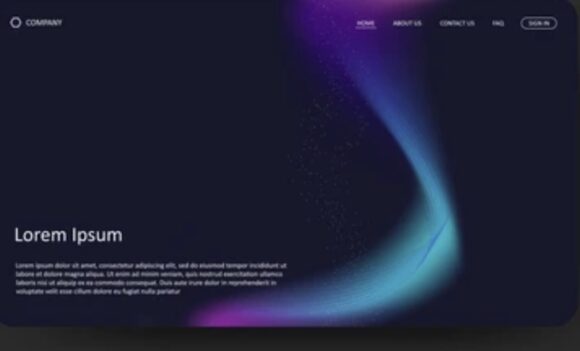Getting your landing page right is like crafting a fine-tuned instrument. Every element – from the layout to the call-to-action – plays a crucial role in the overall performance. A high-performance landing page must cater to your audience’s needs, connecting with them instantly and compelling them to act.
A clear and focused design sets the foundation. Visitors should immediately understand what you offer and why it matters to them. Avoid clutter by focusing on a single message. Each section needs to flow logically to guide the user toward your desired action, whether it’s signing up, purchasing, or contacting you.
Alignment with your audience’s needs should also be a priority. This means tailoring both design and content to resonate with their specific pain points and preferences. If your audience is tech-savvy, a sleek and modern design works. If they value authenticity and trust, your content should reflect those aspects.
Next, establishing trust is pivotal. Incorporate elements like testimonials, client logos, or awards to enhance credibility. This includes using clear, truthful language and ensuring transparency about what happens when a user engages with your calls to action.
Lastly, remember the power of visuals. Images and videos aren’t mere decoration. They’re essential in capturing attention and demonstrating value quickly. Use high-quality visuals that speak to the benefits your service or product offers.
In sum, creating a landing page that performs requires dedication to clarity, alignment with your target audience, and a trustworthy, visually appealing presentation. Every element, when tuned perfectly, contributes to the overall success and conversion rates of your page.
Pitfalls of Poor Landing Page Design
Landing page design is like the backbone of user interaction. If it’s weak, the whole page doesn’t stand up well in the competitive web space. Some mistakes crop up more often than you might think, and they can drastically affect your conversion rates.
Cluttered layouts are a common offender. Overloading a page with information or images can overwhelm visitors, making it tough for them to focus on the call-to-action. Keeping the design clean and organized helps users navigate with ease and directs their attention to the most vital parts.
Another pitfall is poor responsiveness. With diverse devices in play today, if your page doesn’t adapt to different screen sizes, you risk losing a huge chunk of potential customers. Responsive design isn’t just a plus; it’s essential to keep everybody engaged, no matter how they’re accessing your page.
Color schemes also play a critical role. They’re more than just an aesthetic choice; they set the tone and reinforce your brand identity. Selecting jarring or clashing colors can distract and even deter visitors. A balanced palette should support the text’s readability and highlight important actions without overwhelming.
Ignoring loading times is a mistake you can’t afford. Slow pages can send users packing faster than anything else. Compress images, use efficient code, and consider tools to cache content, ensuring visitors don’t lose interest waiting for your page to load.
Lastly, not integrating user feedback into your design updates can leave your page feeling out-of-touch. Users provide insights that can guide you to real improvements, so keep an ear open and be ready to adapt.
Overall, avoiding these design mistakes while keeping an eye on the latest trends ensures your landing page remains inviting and effective, setting the stage for successful user engagement.
Content Mistakes that Sabotage Success
Content is the heart of your landing page, and getting it wrong can seriously undermine your efforts. An all-too-common issue is being vague. Visitors need clear, direct information to make decisions. Jargon-heavy or fluffy language just gets in the way and can lead to confusion or apathy.
It’s also crucial to align the content with your audience’s language and tone. Speaking in terms that resonate with your target market makes it easier for them to connect with your message. This connection is what turns interest into action, especially if you can tap into their problems and offer real solutions.
Failing to highlight value propositions prominently is another critical mistake. A landing page must communicate its core benefits quickly rather than burying them in dense paragraphs. Visitors need to know ‘what’s in it for them’ at a single glance, encouraging them to stick around and explore more.
A lack of call-to-action (CTA) clarity can doom a page, too. Every CTA should be unmissable and urge users to take immediate action. Whether it’s “Sign Up Now” or “Get Your Free Trial”, ensure each button or link clearly communicates the next step.
Neglecting the E-E-A-T principles (Experience, Expertise, Authoritativeness, Trustworthiness) can damage your page’s credibility. Incorporate elements that build trust, like testimonials or credible statistics, and always ensure your content is accurate and up-to-date.
Finally, remember that the structure and readability of your content matter. Break up text with bullet points, headers, and visuals to make information digestible. This keeps users engaged longer and nudges them toward conversion as they navigate the page more easily.
Strategies to Increase Landing Page Traffic
Generating traffic to your landing page is just as crucial as designing it well. To kick things off, a solid mix of organic and paid strategies is your best bet. Search engine optimization (SEO) brings in users through keywords that align with your audience’s queries, driving organic growth over time. Make sure your content answers relevant questions clearly and effectively to improve your rankings.
Paid ads, on platforms like Google Ads or social media channels, can give you a quick boost. They’re effective for targeting specific demographics and getting instant visibility. Plus, the data you collect from these campaigns helps refine both your targeting and content strategy.
Leverage social media to its full potential by sharing compelling snippets or visuals that link back to your landing page. Use platforms that your target audience frequently visits, which increases your chances of engagement. Collaborating with influencers who align with your brand can also extend your reach by putting your page in front of their followers.
Audience targeting doesn’t stop at demographic information. Behavioral insights play a huge role in understanding and predicting what will drive users to your page. Tools like Google Analytics provide deep insights into user behavior, helping you tweak your strategies to better meet their needs.
Ultimately, building a robust traffic strategy involves iteration and adaptation. As your audience’s preferences shift, or as new channels emerge, adapting your approach keeps your page traffic healthy and growing. Staying ahead of these trends means continuously monitoring and optimizing your traffic channels based on data-driven insights.
Optimizing for Better Conversion Rates
Once you’ve got a solid stream of traffic flowing to your landing page, turning these visitors into customers or leads is the ultimate goal. Improving conversion rates starts with understanding what motivates your audience. Talk to them directly or use surveys to gather insights on their needs and preferences.
Crafting a powerful call-to-action (CTA) is essential. A well-designed CTA stands out and uses actionable language that urges the visitor to make a move. It should be prominently placed to catch attention without being overly aggressive.
Another tip for boosting conversion is to streamline the user journey. Remove unnecessary steps in the conversion process to make it as straightforward as possible. If a form is too long, consider reducing the fields or splitting it into smaller sections.
Social proof can be a game-changer. Including testimonials, case studies, or client reviews on your landing page builds trust and credibility. People often look for reassurance from others before making a decision, so showcasing real experiences can tip the scales in your favor.
Aligning your landing page content with the stage of the buyer’s journey can also boost conversions. For instance, provide educational content for new visitors and in-depth guides for those closer to making a decision. Tailoring content to different stages ensures you meet visitors where they are, nudging them further along the path to conversion.
A/B Testing for Continual Improvement
A/B testing is a powerful tool for refining your landing page’s effectiveness over time. This technique involves comparing two versions of a page to see which performs better, allowing data to guide your improvements.
Begin by identifying the elements worth testing, like headlines, CTA buttons, or layouts. It’s critical to change only one element at a time to ensure your results are clear and focused. This way, you know exactly what influences any changes in user behavior.
Setting clear goals is essential in testing. Whether you’re aiming to increase click-through rates or boosting sign-ups, having specific targets helps measure success accurately. Use tracking tools to collect data and keep an eye on how each version performs against these goals.
Once you have your data, analyze it to uncover patterns or insights. Look for significant changes in user navigation or engagement. These insights form the basis for further iterations to refine your landing page continuously. Don’t be afraid to experiment based on what the data suggests.
A great example of successful A/B testing could involve adjusting the color of a CTA button. You might find that a brighter hue draws more clicks. Another possibility is testing different headline lengths or images to see what captures attention best.
Commit to ongoing testing as part of your strategy. The digital landscape changes swiftly, and A/B testing ensures that your landing page remains optimized, up-to-date, and effective at converting visitors.
Troubleshooting Low Performance: Quick Fixes
If your landing page isn’t hitting the mark, it’s time to dig into the data and identify weak spots. Analytical tools are your best allies here. They reveal where visitors might be dropping off or what sections they’re ignoring.
Loading speed issues can be a real thorn in the side. Compress images and minify code to shave off precious seconds. A faster page keeps potential customers engaged and reduces bounce rates.
Check your calls-to-action. If they aren’t generating clicks, try experimenting with different wording, color, or positioning. Sometimes a simple tweak can lead to a significant uptick in engagement.
Content clarity is another area to scrutinize. Ensure your message is concise and your value proposition stands out. Confusing or overly complex language can alienate visitors and drive them away.
Look at how mobile-friendly your page is. More traffic comes from mobile devices than ever, so your page needs to be just as smooth on a smartphone as it is on a desktop.
Remember, not all fixes need to be massive overhauls. Sometimes, small, incremental changes can yield substantial results when addressing low performance. This approach allows for quicker adjustments and less interruption in user experience.
Creating a Seamless Checklist for Marketers
Building a landing page that converts involves juggling multiple techniques, and a structured checklist keeps everything in line. Start by listing essential elements like a strong headline, clear calls-to-action, and persuasive content. Ensuring these are check-marked makes sure the fundamentals are never overlooked, no matter how many pages you create.
Design is another vital column on your checklist. It needs to be visually appealing yet functional. Regularly update this to reflect the latest trends or shifts in consumer preferences. Keeping the UI intuitive and user-friendly should always make the list.
SEO can’t be ignored either. Check that your keywords are expertly integrated, not just sprinkled randomly. Plus, ensure your meta descriptions and alt texts are optimized to boost your page’s visibility in search engines.
Add a segment for technical checks too. This includes loading speeds, mobile optimization, and broken link fixes. Regular audits prevent these issues from slipping under the radar, enhancing the overall user experience.
To maximize efficiency, incorporate tools and automation where possible. Various platforms exist to streamline the testing, monitoring, and updating processes. These tools can save time and provide valuable insights.
Ultimately, a comprehensive checklist acts as a guide to creating, maintaining, and refining high-performing landing pages. Tailor this to suit specific project needs, and keep it dynamic, allowing for evolution alongside your marketing strategies.








